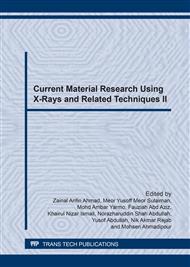[1]
R.H. Kupaei, U.J. Alengaram, M.Z.B. Jumaat, A review on fly ash-based geopolymer concrete, Electronic Journal of Structural Engineering, 13 (2013) 1-6.
DOI: 10.56748/ejse.131652
Google Scholar
[2]
P. Chindaprasirt, C. Jaturapitakkul, W. Chalee, U. Rattanasak, Comparative study on the characteristics of fly ash and bottom ash geopolymers, Waste Manage. 29(2) (2009) 539-543.
DOI: 10.1016/j.wasman.2008.06.023
Google Scholar
[3]
C.L. Hwang, T.P. Huynh, Effect of alkali-activator and rice husk ash content on strength development of fly ash and residual rice husk ash-based geopolymers, Constr. Build. Mater. 101 (2015) 1-9.
DOI: 10.1016/j.conbuildmat.2015.10.025
Google Scholar
[4]
A. Mishra, D. Choudhary, N. Jain, M. Kumar, N. Sharda, D. Dutt, Effect of concentration of alkaline liquid and curing time on strength and water absorption of geopolymer concrete, J. Eng. Appl. Sci. 3(1) (2008) 14-18.
Google Scholar
[5]
E. Diaz-Loya, E.N. Allouche, S. Vaidya, Mechanical properties of fly ash-based geopolymer concrete, Aci. Mater. J. 108(3) (2011) 300-306.
Google Scholar
[6]
K.J.D. Mackenzie, M. Welter, Geopolymer (aluminosilicate) composites: synthesis, properties and applications, in: I.M. Low, Advances in Ceramic Matrix Composites, Woodhead Publishing, Oxford, 2014, 445-470.
DOI: 10.1533/9780857098825.3.445
Google Scholar
[7]
J. Davidovits, Geopolymer Chemistry and Applications, third ed., Institut Géopolymère, Saint-Quentin, France, (2011).
Google Scholar
[8]
M.M.A.B. Abdullah, L. Jamaludin, K. Hussin, M. Bnhussain, C.M.R. Ghazali, M.I. Ahmad, Fly ash porous material using geopolymerization process for high temperature exposure, International Journal of Molecular Sciences 13(4) (2012) 4388-4395.
DOI: 10.3390/ijms13044388
Google Scholar
[9]
W.I.W. Mastura, H. Kamarudin, I.K. Nizar, A.B.A.M. Mustafa, H.M. Amjad, Effect of curing system on properties of fly ash-based geopolymer bricks, in extracted by ICOME 2012 virtual forum-3RD internatinal conference on mechanical engineering (2013).
DOI: 10.4028/www.scientific.net/amr.626.937
Google Scholar
[10]
D.V. Dao, J.P. Forth, Investigation of the behaviour of geopolymer mortar after heating to elevated temperatures, in proceedings of the 3rd international conference on sustainable construction materials and technologies (2013).
Google Scholar
[11]
N. Ranjbar, M. Mehrali, U.J. Alengaram, H.S.C. Metselaar, M.Z. Jumaat, Compressive strength and microstructural analysis of fly ash/palm oil fuel ash based geopolymer mortar under elevated temperatures, Constr. Build. Mater. 65 (2014) 114-121.
DOI: 10.1016/j.conbuildmat.2014.04.064
Google Scholar


